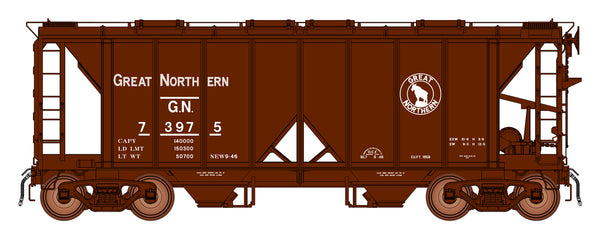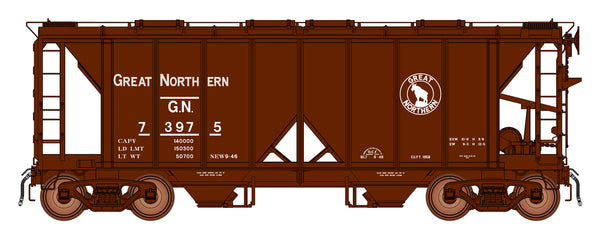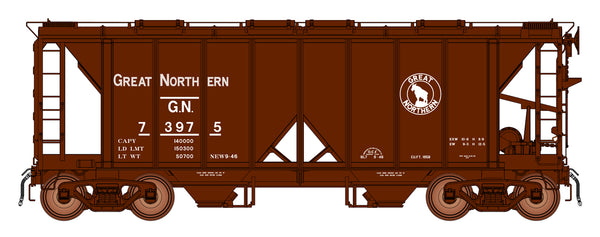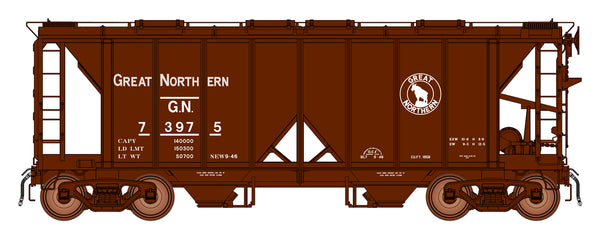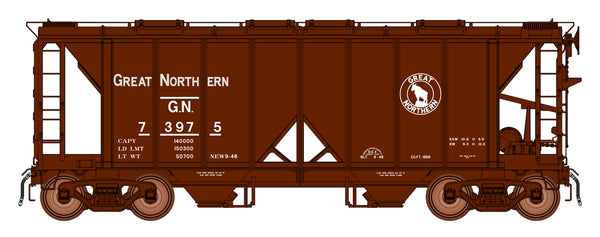C4 70 ton 1958 cubic foot ACF covered hopper, Mineral Red
HO scale, with trucks and magnetic couplers. Six car numbers available.
Cement is a binder that sets, hardens, and adheres to other materials to bind them together. The most common type, Portland cement, is made by roasting limestone, with other materials such as clay, to 2,640 degrees Fahrenheit in a kiln to form calcium silicates. Clinker from the kiln, plus a small amount of gypsum, is ground into a powder to make ordinary Portland cement, which is used to make concrete, mortar, and grout. Portland cement is very dense, weighing 85 pounds per cubic foot.
During the 19th century, cement was transported in wooden barrels that held 300 pounds of cement, and later in paper sacks, both expensive in packaging and in labor cost to load and unload box cars. Starting in 1935, GN assigned 40 ton box cars to on line plants supplying bulk cement for construction of Grand Coulee Dam in north central Washington state. These cars were unloaded using Fuller Kinyon pumps and may well have been loaded the same way. A photo on page 10 of RS 408 shows GN 9944 stenciled “Cement Loading Only, Bulk Cement, Load to Coulee Area Only” taken in September of 1951, probably at Concrete WA.
The first rail car specifically designed to transport the moisture sensitive commodities Portland cement and rock salt in bulk was the all steel covered hopper car with a fixed roof with loading hatches. American Car and Foundry (ACF) built the first known covered hopper car, an experiment for Anheuser-Busch, in 1911. For the next 20 years railroads modified a few of their hopper cars with shop built covers, most for cement service. Like open top hoppers, covered hopper cars were unloaded by gravity flow out of the bottom hoppers.
The first commercial covered hopper cars were built for carbon black service in 1933. The first new built railroad fleet was the Pennsylvania’s H30 design of 1935, a 70 ton car of 1973 cubic feet. In 1937 ACF introduced its 1958 cubic feet, nominal 70 ton capacity, design that would dominate the cement car market until the introduction of nominal 100 ton cars in the early 1960s. The 1937 Car Builders Cyclopedia showed covered hoppers for carbon black, cement, dry sand, phosphates, and kaolin clay. Covered hopper cars were and are AAR car type LO, and 70 ton cars were GN car type code C4.
Great Northern made its first purchase of five covered hopper cars, from ACF for cement service, in 1940. The next purchase, of 25 cars, came in 1946. An additional 375 cars in 1949, 1951, and 1953 brought the total fleet of 1958 cubic feet cars to 405. The majority of the post 1946 cars were built by Pullman Standard and General American to the ACF design, presumably under license.
Our InterMountain model is numbered in series GN 73970-994, the 25 car lot purchased from ACF in 1946. The model is painted in the mineral red scheme that these cars were delivered in and is appropriately stenciled including the ‘Great Northern’ herald. These cars were repainted to a gray body color by 1954 and were renumbered to 71200-71224 in the late 1950s.
This model is a based the mass produced prototype of its time, which the GN purchased significant numbers of in several lots. They fill an important niche in the Great Northern’s fleet. This car is the only Great Northern 70 ton cement service covered hopper available.
See also Reference Sheet 59 and 408.







